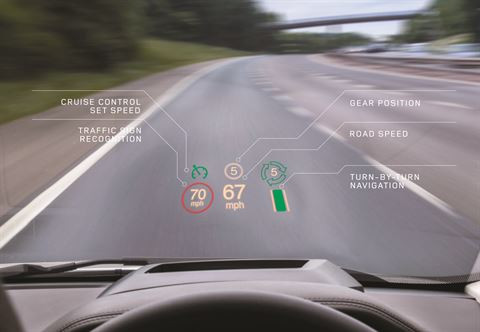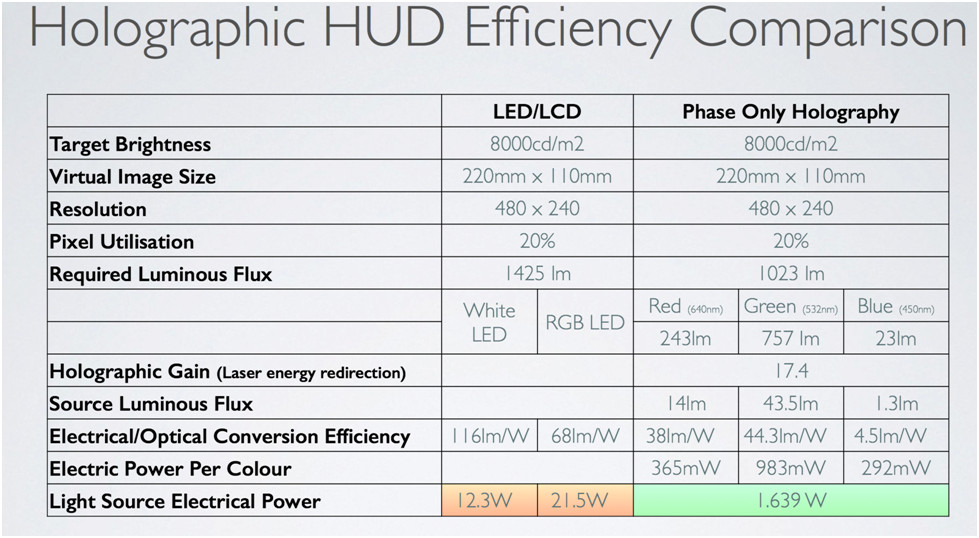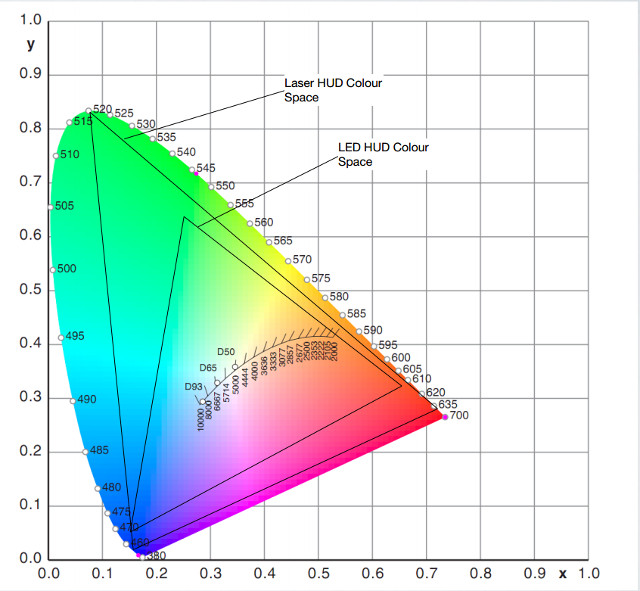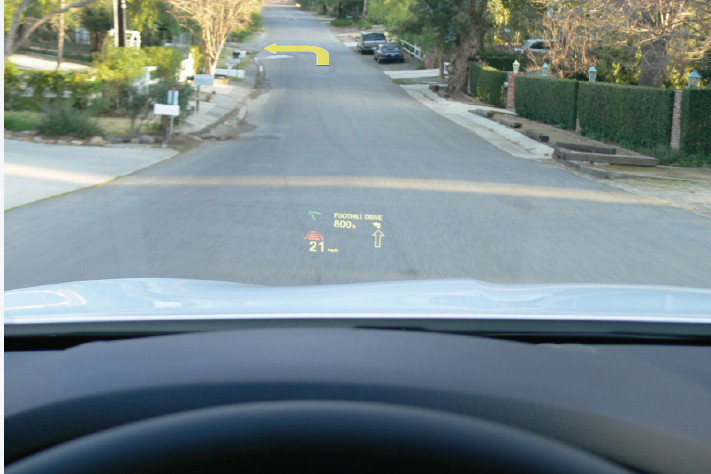Automotive – We have reported that Jaguar now offers a heads up display (HUD) in the XE model and it will soon be available in the Range Rover Evoque as well. Now, we can reveal the technology behind this HUD. A company called Two Trees Photonics Limited (Milton Keynes, UK) developed the HUD using an analog holographic technique. While the specs on the HUD are similar to other models on the market, the technology to get there is completely different – with lots of advantages like significant reductions in size, weight and power consumption.
Two Trees has just emerged out of stealth mode and we had a chance to chat with Jamieson Christmas, the company CTO, about the technology. He told us that about 10 years ago, two groups in the same Cambridge University laboratory were working on holographic display technologies. One group went on to become Light Blue Optics and the other was sponsored by Alps Electric. Light Blue Optics chose to pursue the implementation of binary holographic projectors using LCOS panels as phase modulators with laser illumination. Alps Electric took the other path – using LCOS modulators and laser illumination, but creating analog holograms instead.
Binary holographic displays require less processing power to compute the holograms (only two phase levels), but the image quality and contrast are not as good as with analog holographic projection. But the analog approach requires more processing power.
 Two Trees was formed in January 2010 with backing from Alps Electric Ltd, a major Japanese electronics manufacturer, with the sole aim of further developing the holographic display technology. The company worked quietly to develop the technology, initially self funding the start up until a major customer (Jaguar with Alps) provided the engineering funds to continue development. By mid 2010 the company had developed its first prototype HUD and it has worked ever since with its automotive manufacturing partner to bring the concept into commercial production. That day has now arrived, with partners doing the actual HUD manufacturing and Two Trees doing the development work.
Two Trees was formed in January 2010 with backing from Alps Electric Ltd, a major Japanese electronics manufacturer, with the sole aim of further developing the holographic display technology. The company worked quietly to develop the technology, initially self funding the start up until a major customer (Jaguar with Alps) provided the engineering funds to continue development. By mid 2010 the company had developed its first prototype HUD and it has worked ever since with its automotive manufacturing partner to bring the concept into commercial production. That day has now arrived, with partners doing the actual HUD manufacturing and Two Trees doing the development work.
So what is the big advantage for using holographic projection? The main advantage is the ability to direct the laser light into only the objects you want to display.
In conventional projectors, the LCOS panel is flood illuminated by light (LED, laser or other) and the image is created by modulating the light pixel by pixel. To show one bright pixel still requires you to illuminate and modulate the entire panel throwing away 99% of the light. For more typical applications of showing symbology in a HUD, the standard LCD/LED HUD technology only allows about 6% of the source light to reach the driver’s eye.
With a true holographic projector, the LCOS panel is still flood illuminated with laser light, but you drive the panel with different content. Instead of the standard image format, you write a phase hologram of the image you want to create to the panel. This is the heavy lifting part – developing the algorithms and processing engine to do this in real time. With holographic projection, there is no pixel to pixel correspondence between the panel and the created image. If you want that one pixel of light, all of the energy from all the pixels in the panel are used to direct light to that one point on the screen. That means you can use far less power to create a point with brightness equivalent to a traditional projector, or use the same power and create a vastly brighter point – your choice.
This makes holographic HUDs very well suited for the task of displaying symbology as this represents perhaps 20% of the image area allowing all the light to be directed to the symbology. While Two Trees has shown you can display full screen video with its technology, this does not play to its main strength.
While Two Trees is now out of stealth mode, the company is still somewhat limited in what it can say about the Jaguar HUD. What Christmas did say was that it has now developed the processing engine to allow real time calculation of the analog holograms. This has been implemented in low cost FPGA (like the Cyclone class from Altera or the Spartan class from Xilinx). No other components, like a co-processor or DSP are needed.
The optical engine uses an LCOS panel and red, green and blue lasers. The suppliers of the components could not be revealed, but the green laser is a direct diode type. In the chart below, Christmas did a comparison between a typical HUD using an LCD and LED illumination and a phase only holographic HUD using analog holograms. He was careful to note that these specs are not the same as used in the Jaguar HUD. However, he did say that the actual HUD was designed to be performance competitive with existing HUDs, so it is probably pretty close.
As you can see, the target brightness, virtual image size, pixel ultilization and resolution were held the same to compare the optical efficiency of three engines – LCD/White LED; LCD/RGB LED and LCOS/RGB laser. Note the dramatic reduction in electrical power usage in the bottom row for the holographic solution.

The laser sources also deliver a very large color gamut as shown in the figure. However, photos taken of the HUD in the Jaguar don’t really show the high saturation the HUD achieves (it is hard to capture laser-based images). Christmas says the images are also speckle free, but he declined to specify how they do it (most likely a simple diffuser will do the trick).

In addition to the benefits of lower power consumption, the Jaguar HUD is said to be about 1/3 the size and weight of comparable HUDs using LCD/LED technology on the market today. Plus, using the holographic approach means the LCOS panels does not have to be perfect either. Dead pixels and slight misalignments will only marginally affect efficiency, but not image quality.
HUD technology will create new ways for drivers to see and access information. And, there is the possibility to do a lot more. For example, one idea is to add augmented reality to a HUD display that would place a turning arrow at the right location in the field of view and adjust it as the car moves toward it.

And Jaguar has showed advanced concepts that utilize the whole windshield to display information (see this article). Two Trees has a unique and very interesting technology – one ideally suited for the HUD market. Will others try to follow?
Going to the SID Vehicle Display conference Oct. 23-24? Two Trees will be attending. – Chris Chinnock

